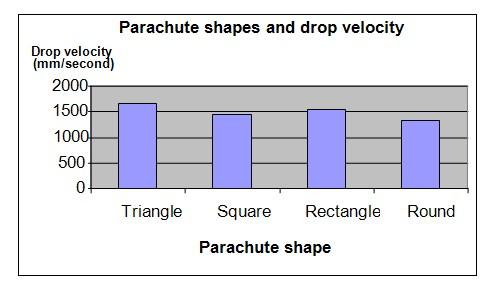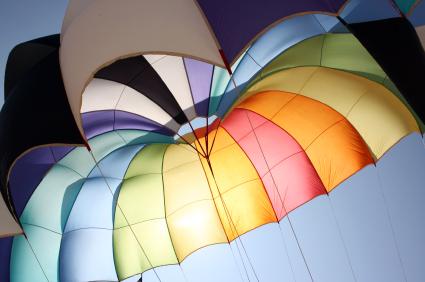| Complexity level: | 8 |
| Project cost ($): | 20 |
| Time required: | It will take an hour to set up the science fair project, and an hour to conduct it |
| Material availability: | The materials can be purchased from a hardware store. |
| Safety concerns: | Basic safety requirements. Adult supervision recommended. |
Hypothesis
Among the parachutes, the round parachute will take the longest to land.
Overview
How a parachute works
There are 2 forces at work when a parachute descends. The force of gravity pulls an object to the earth. It causes elevated objects to fall from their place. If however, the object is attached to a parachute, an upward drag force is exerted on the object as well. This is because there is a certain level of air resistance against a parachute’s canopy, and this slows down the objects fall.
If a jumper descends too quickly, he may reach the ground too soon and hurt himself. When a jumper uses a parachute that has a large canopy, his drop velocity reduces, and he will descend safely. Generally, it is safe to land at a speed of up to 5km/h.
Currently, parachutes come in various shapes and sizes. For military and cargo drops, it is important to use round or mushroom shaped parachutes. These take advantage of the greater amount of air drag during descent. Extreme sports enthusiasts seldom use round parachutes.
When a jumper uses a rectangular parachute, he experiences a fast descent plus forward motion. The jumper then needs to run when he/she lands.
Scientific Terms
Materials
The materials required for this science fair project are as follows:
- 4 plastic bags that each have a surface area of at least 500 square centimeters
- 15 threads that each are about 400 mm long
- 4 washers that have a weight of about 5g each
- a measuring tape
- a stopwatch
- an assistant
- a building with a balcony on its second floor
Procedure
1. For this science fair project, the independent variable is the shape of the parachutes’ canopies. The dependent variable is the drop speeds of the parachutes. How long does it take for the parachutes to reach the ground? Measure this using a stopwatch. The constants (control variables) are the surface area of the canopies, the weight of the nails, and the height from which the parachutes are dropped.
2. Cut a triangle, a square, a rectangle and a circle from 4 plastic bags. Each shape should have an area of 500 square centimeters. Calculate how long the sides and diameters of the shapes should be, before cutting them out.
3. Punch 3 holes in the corners of the triangular canopy. Punch 4 holes in the corners of the square and rectangular canopies, and 4 holes in the round canopy. Tie 1 end of the strings to the holes in the canopies and the other end of the strings to the washers.
4. With the help of an assistant, measure the length of the distance between a balcony on the second storey the building, and the ground. Use a long measuring tape. This distance shall be the drop distance.
5. Have your assistant drop the parachutes from the balcony while you wait downstairs with the stopwatch. At the same time, ensure that the parachutes do not land on passersby.
6. Calculate the drop speed of the parachute and record in the table below. Use the formula below:
Drop speed = distance traveled / time taken
Scientific Terms and Concepts:
Gravity, drag, force, air resistance, velocity

Results
The round parachute took the longest amount of time to land and the triangular parachute took the least amount of time.
|
Shapes of parachutes |
Drop height (mm) |
Drop time (s) |
Drop velocity (mm/s) |
|
Triangle |
4800 |
2.9 |
1655.2 |
|
Square |
4800 |
3.3 |
1454.5 |
|
Rectangle |
4800 |
3.1 |
1548.4 |
|
Round |
4800 |
3.6 |
1333.3 |
The chart below represents the results of our science experiment

Conclusion
The hypothesis holds true: among the parachutes, the round one took the longest amount of time to land. The round canopy had the least amount of air that escaped from its sides, fully utilizing its surface area by building up air resistance and lowering the drop velocity.
In previous wars, the military used parachutes to drop paratroopers and supplies safely beyond enemy lines. At present, they are used primarily for humanitarian purposes; to deliver medicine and food to inaccessible areas (these areas may be inaccessible because of their remoteness or because they have been hit by natural disasters). For extreme sports enthusiasts, parachuting, skydiving and base jumping are popular activities.
Also consider
Use parachutes that have surface areas of difference sizes.
Drop the parachutes from different heights.
References
Parachute - http://en.wikipedia.org/wiki/Parachute
How does the parachute work? - http://www.buzzle.com/articles/how-does-the-parachute-work.html

